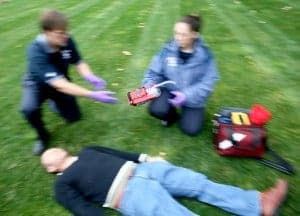
Dan Limmer, BS, NRP

by Dan Limmer, BS, NRP
Our articles are read by an automated voice. We offer the option to listen to our articles as soon as they are published to enhance accessibility. Issues? Please let us know using the contact form.
I recently taught at an EMS conference in Connecticut. The topic of suctioning came up. We talked about how we’d been taught wrong for some time. If wrong seems like a tough word—then at the very least we can say that what we learned is unrealistic. This is what we were taught for years:
Suction for no longer than 15 seconds.
Why is this wrong? Because people may vomit for longer than 15 seconds, or it may take longer than that to remove copious vomit or vomit that is difficult to suction.
What should we be teaching instead?
Suction quickly and efficiently to remove vomit or secretions before ventilating.
What’s the difference between the two statements above?
The difference is thinking. EMTs know a series of facts. Critical thinking is the application of these facts appropriately under pressure. The facts include that:
hypoxia will eventually kill a patient.
the longer you suction, the more hypoxic the patient will become.
ventilating stomach contents into the airway will cause aspiration pneumonitis and will also likely kill your patient (although it may be a week later in the hospital).

So, if we truly understood the principles above, we’d combine them in practice to come up with this answer:
Suction quickly and efficiently for as long as it takes to remove all the foreign material, and then ventilate and oxygenate effectively.
Isn't that better than an arbitrary blanket statement like "Suction for no longer than 15 seconds”?
As best I can tell, the "15-second rule" came from advanced practice and hospitals where intubated patients could be suctioned, ventilated and suctioned again with a protected airway. It isn't that clear cut in the field.
Take-home points from this post:
Thinking and decision making are vital for the EMT. Arbitrary rules don't work and don't prepare EMTs for the field—namely, the patient who has volcano-vomited the partially digested pasta dinner for the past 45 seconds.
Medicine (which includes EMS) is a series of important decisions based on benefits and risks. Sometimes there is no good answer (die from hypoxia, or die from aspiration?), so we have to think on our feet and make appropriate decisions in less-than-ideal situations.
The decisions built into this scenario—suction or ventilate?—pose the exact kind of dilemma seen in the field. The NREMT exam is based on decisions like this, where there is no great answer but the EMT still must make the best choice from among the ones available. The reason students don't feel prepared to deal with ambiguity, either in the field or on the exam, is that in class many things are done by strict rule rather than by evaluating the options and considering the benefits and risks of each.
It’s time for educators and students to shed the safety net of concrete facts and enter the nonlinear, thinking-based world of real-life EMS.
See also:

Dan Limmer, BS, NRP

Mike Miller
Andrew--very true. As an educator I would also say that it is beneficial to have students like you as opposed to those who just want something to memorize to pass the test!
It has been great seeing you on the webinar as well as on posts like these. Keep learning!
IMO, it helps to have, at the level of EMT-B classes, an instructor who is not afraid to challenge the book / Ntl. Registry exam questions and to differentiate between them and field practice. Luckily I have had / am still having one of those.
I love the direction EMS training is going. Challenge tradition with actual clinical practice and perspective. One way to implement this is to have students challenge textbook dogma in the context of reality. Suddenly, the weight of dogma is lessened and we have thinking students rather than fact-regurgitating ones. Well put.
It is exciting--and we may have only seen the tip of the iceberg thus far!